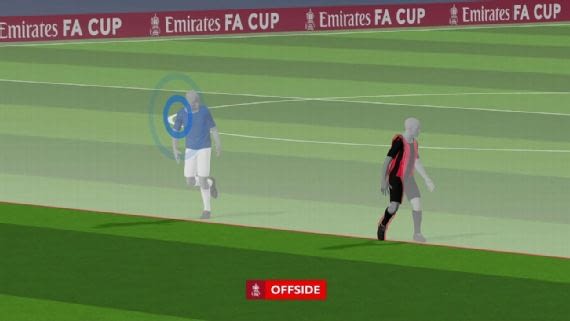Premier League Embraces Semi-Automated Offside Technology: A New Era Begins
The Premier League is stepping into a new era of officiating with the introduction of semi-automated offside technology (SAOT). After two years of rigorous testing with various artificial intelligence-based providers, the league is ready to roll out this cutting-edge technology. This move follows in the footsteps of UEFA, which first introduced SAOT in the Champions League at the start of the 2022-23 season, and FIFA, which implemented it during the World Cup in Qatar.
SAOT made its debut in English football during the FA Cup fifth round on February 28, 2025, featuring in seven ties played at Premier League grounds. After successful live trials, the technology is set to be introduced into the Premier League for Matchweek 32, from April 12-14.
Why Did VAR Offside Need to Change?
For years, fans, players, and coaches have expressed frustration with the existing VAR offside system. Long delays, perceived inaccuracies, and a lack of confidence in the “crosshairs” system were just the tip of the iceberg. The poor visualization of decisions, with lines placed on the pitch that often contradicted a viewer’s perspective, added to the skepticism. A player might appear onside, but the technology would declare them offside. In other instances, the lines were so close that the outcome was hard to comprehend.
One of the major issues was selecting the exact moment the ball was touched by the passer, which couldn’t be determined accurately due to the frame rate of TV cameras (50 frames per second). The VAR had to manually select the farthest forward point on both the defender and attacker using “crosshairs,” a process that was neither consistent nor accurate. This often led to lengthy decision times, sometimes up to five minutes for complex calls.
Some stadiums, like Selhurst Park, posed additional challenges. Earlier this season, it took over four minutes to confirm a Crystal Palace goal. Such delays eroded trust in the process, compounded by high-profile errors. For instance, in February 2023, the VAR failed to identify a Brentford player offside in a goal against Arsenal. On the same day, lines were placed on the wrong Crystal Palace defender, leading to a Brighton & Hove Albion goal being incorrectly disallowed.
In October 2023, Liverpool had a goal ruled out for offside at Tottenham Hotspur, which the VAR mistakenly failed to correct. The error on the Luis Díaz goal was primarily a communication issue rather than a technological one. While SAOT can’t fix communication errors, a less complicated process might help prevent them.
What is Semi-Automated Offside Technology?
Developed by Genius Sports, the Premier League’s SAOT aims to create a “more efficient placement of the virtual offside line” by automating the mapping of relevant players. This takes the responsibility out of the VAR’s hands and places it in the control of technology. Instead of a referee placing lines on a 2D TV screen, SAOT plots players in 3D, offering an “enhanced in-stadium and broadcast experience for supporters.”
What Does It Look Like?
Visualization is a crucial aspect of this project. Previously, it was challenging to visualize offside decisions, but now a 3D animation will align fans with the assistant referee’s perspective. The animation, similar to goal-line technology, will be shown at the stadium, on TV, and posted on the @PLMatchCentre X account.
The animation highlights the body parts of the attacker deemed offside (or not, if onside) and creates a “wall” indicating the offside line. If a player is offside, the relevant body part will break through that “wall.” Unlike SAOT in other competitions, the animation won’t move directly in line with the two players to avoid confusion. However, it’s yet to be seen if fans will embrace this method.
In theory, this should make it easier for supporters at the ground or watching on television to understand decisions, and fewer delays should lead to less criticism. In the Champions League, the animation takes several minutes to be shown as it’s overlayed onto the original TV coverage. In the Premier League and the FA Cup, it will be standalone, so it should be much quicker.
First Goals Disallowed Through SAOT
The first goal disallowed through SAOT was Fabian Schär‘s late “winner” for Newcastle United against Brighton & Hove Albion in the FA Cup on March 2. Brighton went on to win the game in extra time.
In the Premier League, the first use of SAOT occurred during Manchester City’s match with Crystal Palace on April 12. The referee’s call of no goal was checked and confirmed by the VAR, with Palace forward Eberechi Eze deemed offside. Arsenal fans will remember Kieran Tierney’s opener against Brentford as the first goal ruled out via SAOT, after he was deemed offside before heading home on April 12.
Why is SAOT Better?
Accusations of human error have often plagued VAR and offside decisions. By automating the process, SAOT aims to eliminate operator bias. It’s semi-automated because the VAR still needs to confirm the result, as the technology can’t determine if an attacker is actively involved in play or confirm the ball was touched by a teammate.
The VAR also validates the kick point, as there’s no chip in the ball in the Premier League version of the technology. SAOT automates the mapping process and produces results more quickly, cutting the average time for an offside VAR review by 30 seconds. In a game between Chelsea and Tottenham Hotspur, an offside review took over four minutes, but in offline trials of SAOT, it was two minutes quicker.
The Premier League believes SAOT increases confidence in decision-making by reducing reliance on manual checks, thus reducing the likelihood of missed decisions, like the one in Arsenal vs. Brentford.
How Does SAOT Work?
The Premier League’s SAOT uses a FIFA-validated iPhone-based system known as “Dragon,” rather than lower frame rate broadcast cameras. There are 30 iPhones (the number may vary by stadium design), model 14 or newer, installed under the roof of the 20 Premier League grounds.
These cameras provide optimal tracking for the ball and all 22 players, recording 10,000 surface “mesh” data points per player on all limbs and extremities relevant for an offside decision. Data is captured at 100 frames per second, double the 50 frames per second used in the old technology.
All player and ball data is processed in real time, triggering an alert to the VAR. An offside player can be automatically “flagged” in the SAOT software. The VAR must then validate the kick point, the accuracy of the offside line, and whether the offside player touched the ball or impacted play, before informing the referee.
Potential Shortcomings
Despite its advantages, SAOT isn’t foolproof. In a game between AFC Bournemouth and Wolverhampton Wanderers in the FA Cup, an eight-minute VAR check involved two possible handballs and an offside. The goal was eventually ruled out for offside, but the VAR had to revert to the old “crosshairs” technology.
The Football Association has stated that “the VAR will still have the option to draw crosshairs as a backup to the SAOT system if required. This process may be necessary in ‘edge cases’ where several players block the view of the ball or other players for the system’s cameras.”
Why No Chip in the Ball?
While a chip in the ball provides greater accuracy, Adidas, the provider for FIFA and UEFA, developed the original SAOT and owns the patent for the chip’s placement. This patent means other ball manufacturers need to find a new way to balance a chip without infringing on Adidas’s patent. The chip system is expensive and used only in major tournaments like Euro 2024 and the World Cup. Even for the Champions League, UEFA uses a non-chip system like the Premier League.
Without the chip, SAOT suggests a kick point to the VAR and automatically creates the offside line. The VAR checks the frame before approving the final decision. Tony Scholes, the Premier League’s chief football officer, believes the lack of a chip won’t be a problem, stating, “We believe we’re going to be adopting the best system and the most accurate system without the need for the chip in the ball.”
Why the Premier League’s System is More Accurate
The Premier League’s SAOT is considered more accurate due to its method of mapping players and the number of cameras used. The system maps 10,000 surface “mesh” data points per player, compared to FIFA and UEFA’s 29 data points. The Premier League uses, on average, 30 cameras, while FIFA and UEFA use 10-12. The iPhones capture data at 100 frames per second, double the speed of broadcast cameras used by FIFA and UEFA.
More Accurate, But More Offside Goals?
The Premier League will retain the existing “tolerance level,” giving a “benefit of the doubt” to the attacker of around 5cm. This was introduced in 2021-22 after complaints about “toenail” calls. No other league with SAOT uses a tolerance level, making the most marginal of calls. If the Premier League had removed the “tolerance level,” more goals would be disallowed. However, the league’s retention of this level suggests it isn’t entirely confident in its accuracy.
Will There Still Be Long Delays?
Longer delays should be rarer, as SAOT eliminates the manual process of mapping players. However, subjective elements, such as whether a player is interfering with play, will still take time. Situations where players block each other in the system’s cameras or multiple checks in one phase will also cause delays.
Will SAOT Be Used for All Offside Decisions?
No, SAOT will only be activated in match-changing moments covered by VAR, such as goals, penalties, and red cards. This means a corner could still result from a missed offside.
What About the Delayed Offside Flag?
While SAOT can quickly determine player positions, it is only used for VAR reviews, so the delayed offside flag will remain. Play will continue in an attacking situation until the end of the phase, when the assistant will raise their flag.
Is SAOT in Other Leagues?
Serie A was the first European domestic league to switch to SAOT, introducing it in January 2023 after a high-profile VAR error. Mexico’s Liga BBVA MX also introduced it in January 2023, and it has been used in the CONMEBOL Libertadores. LaLiga brought in SAOT at the start of the 2024-25 season.
Originally Written by: Dale Johnson





















